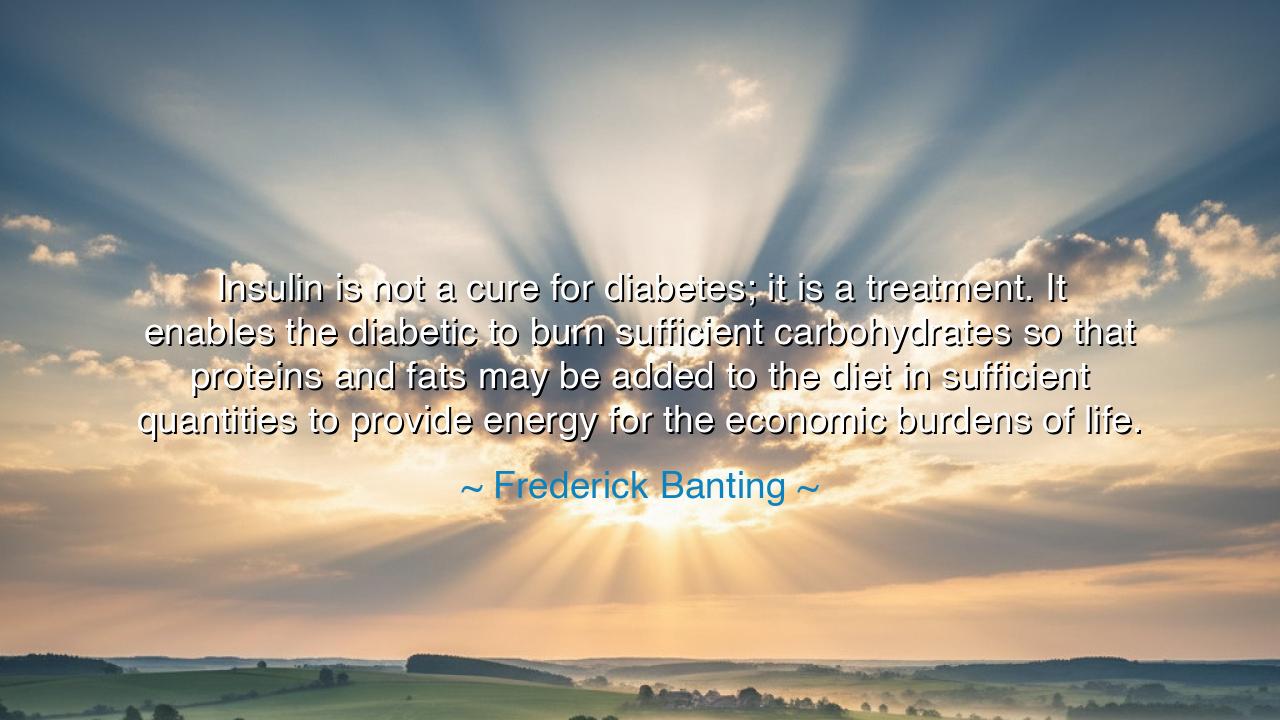
Insulin is not a cure for diabetes; it is a treatment. It enables
Insulin is not a cure for diabetes; it is a treatment. It enables the diabetic to burn sufficient carbohydrates so that proteins and fats may be added to the diet in sufficient quantities to provide energy for the economic burdens of life.






In the words of Frederick Banting, discoverer of insulin, “Insulin is not a cure for diabetes; it is a treatment. It enables the diabetic to burn sufficient carbohydrates so that proteins and fats may be added to the diet in sufficient quantities to provide energy for the economic burdens of life,” there lies a truth both scientific and deeply philosophical. Though he spoke as a man of medicine, his words carry the weight of a timeless principle: that in this mortal life, healing is often not the end of suffering, but the art of endurance. Banting’s declaration is more than an explanation of insulin’s function—it is a meditation on the nature of human limitation, resilience, and the delicate balance between survival and cure.
To say that insulin is not a cure, but a treatment is to speak of the fragile grace by which human life endures. Before Banting’s discovery in 1921, a diagnosis of diabetes was a death sentence. The young and the old alike wasted away as their bodies, unable to process sugar, starved amid plenty. Banting, together with Charles Best, isolated insulin from the pancreas, giving the dying a second chance at life. Yet even in his triumph, Banting refused to call his discovery a miracle. He understood that medicine can sustain life, but not transcend its mortal bounds. Like the philosophers of old, he saw that knowledge is a gift tempered by humility: science can mend, but only nature and time can heal completely.
His insight mirrors the wisdom of Hippocrates, the ancient physician who taught that the healer’s task is not to fight nature, but to assist it. Hippocrates knew, as Banting later confirmed, that every treatment is but a partnership with the body’s own will to survive. Insulin, in Banting’s vision, is not a conqueror of disease, but a bridge—a way for the diabetic to live, to work, to bear “the economic burdens of life.” In his era, when survival itself was a daily labor, this truth carried both dignity and weight. The doctor’s duty, then as now, was not merely to restore health, but to restore the possibility of living meaningfully within one’s condition.
Consider the story of a young girl named Elizabeth Hughes, one of the first children treated with insulin after Banting’s discovery. Before the treatment, she weighed scarcely fifty pounds, her body consumed by starvation. Her father, desperate and fearful, watched her fade. When Banting administered insulin, the girl began to revive—her body regaining strength, her eyes once again alive with hope. Yet Banting told the family plainly: this was not a cure. Insulin would sustain her, but discipline and vigilance must carry her the rest of the way. And so it did—Elizabeth lived into adulthood, bearing the burden of careful living with courage. Her story, like Banting’s words, reminds us that the greatest victories are not always freedom from struggle, but the strength to endure it with grace.
In calling insulin a treatment, Banting also spoke to the deeper moral truth of his time—and of all time. Humanity, in its quest for mastery, often confuses progress with perfection. Yet the wise understand that to sustain life is no lesser miracle than to cure it. Just as a lamp requires constant tending to hold back the dark, so too does the diabetic require the daily discipline of medicine and mindfulness. Banting’s humility in the face of his discovery reveals the spirit of the true scholar: he celebrated not his triumph, but the ongoing responsibility it brought. In this, he mirrors the ancient stoics, who taught that endurance and understanding are greater than the illusion of control.
There is also a quiet reverence in his phrase, “to provide energy for the economic burdens of life.” Here, Banting speaks not only of bodily energy, but of human purpose. Life, even when limited, must still be lived fully. The patient, sustained by treatment, must rise each day to labor, to love, to fulfill the duties of existence. This vision ennobles the act of healing: it is not about erasing suffering, but empowering the sufferer to carry it with strength. In this way, Banting’s medicine becomes not merely chemical, but philosophical—a metaphor for the human condition itself.
Let this teaching be remembered: a cure removes suffering, but treatment teaches endurance—and in endurance lies wisdom. The world is filled with ailments that may never be cured: pain, loss, longing, uncertainty. Yet through courage, through knowledge, through discipline, humanity learns to live not in despair, but in defiance. Banting’s words remind us that every act of healing, no matter how incomplete, is sacred, for it affirms life itself against the encroaching dark.
Thus, the wisdom of Frederick Banting endures beyond the laboratory and into the soul of mankind. He teaches us that progress is not perfection, and that survival, when achieved with dignity, is its own form of triumph. Let all who labor in medicine, in hardship, or in life remember this: to live, even imperfectly, is a victory. To heal, even partially, is divine. And to face the burdens of existence with strength, humility, and hope is the mark not only of science, but of the eternal human spirit.






AAdministratorAdministrator
Welcome, honored guests. Please leave a comment, we will respond soon